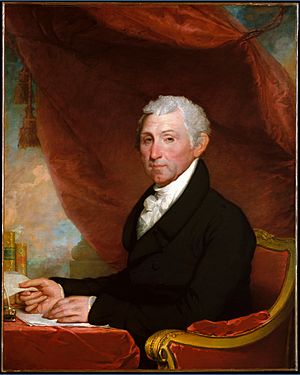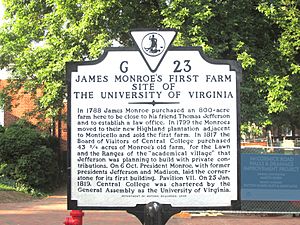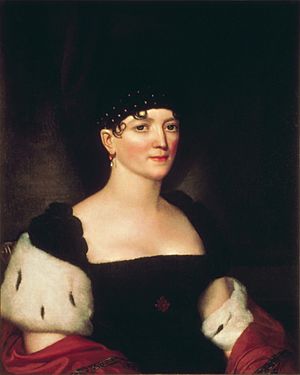James Monroe facts for kids
Quick facts for kids
James Monroe
|
|
|---|---|
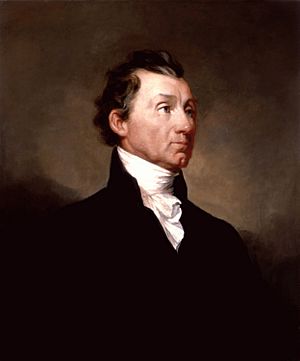
Portrait by Samuel Morse, c. 1819
|
|
| 5th President of the United States | |
| In office March 4, 1817 – March 4, 1825 |
|
| Vice President | Daniel D. Tompkins |
| Preceded by | James Madison |
| Succeeded by | John Quincy Adams |
| 7th United States Secretary of State | |
| In office April 6, 1811 – March 4, 1817 |
|
| President | James Madison |
| Preceded by | Robert Smith |
| Succeeded by | John Quincy Adams |
| 8th United States Secretary of War | |
| In office September 27, 1814 – March 2, 1815 |
|
| President | James Madison |
| Preceded by | John Armstrong Jr. |
| Succeeded by | William H. Crawford |
| 12th and 16th Governor of Virginia | |
| In office January 16, 1811 – April 2, 1811 |
|
| Preceded by | John Tyler Sr. |
| Succeeded by | George W. Smith |
| In office December 28, 1799 – December 1, 1802 |
|
| Preceded by | James Wood |
| Succeeded by | John Page |
| 4th United States Minister to the United Kingdom | |
| In office August 17, 1803 – October 7, 1807 |
|
| President | Thomas Jefferson |
| Preceded by | Rufus King |
| Succeeded by | William Pinkney |
| 5th United States Minister to France | |
| In office August 15, 1794 – December 9, 1796 |
|
| President | George Washington |
| Preceded by | Gouverneur Morris |
| Succeeded by | Charles Cotesworth Pinckney |
| United States Senator from Virginia |
|
| In office November 9, 1790 – May 27, 1794 |
|
| Preceded by | John Walker |
| Succeeded by | Stevens Thomson Mason |
| Delegate from Virginia to the Congress of the Confederation | |
| In office November 3, 1783 – November 7, 1786 |
|
| Preceded by | Constituency established |
| Succeeded by | Henry Lee III |
| Personal details | |
| Born | April 28, 1758 Monroe Hall, Virginia, British America |
| Died | July 4, 1831 (aged 73) New York City, U.S. |
| Resting place | Hollywood Cemetery |
| Political party | Democratic-Republican |
| Spouse | |
| Children | 3, including Eliza and Maria |
| Education | College of William & Mary |
| Occupation |
|
| Signature | |
| Military service | |
| Branch/service |
|
| Years of service |
|
| Rank | |
| Battles/wars | |
James Monroe (pronounced mən-ROH; April 28, 1758 – July 4, 1831) was an important American leader. He was a lawyer, diplomat, and one of the Founding Fathers. Monroe served as the fifth president of the United States from 1817 to 1825. He was a member of the Democratic-Republican Party.
He was the last Founding Father to become president. His time as president is known as the Era of Good Feelings. This was a time when there was less political fighting in America. Monroe is most famous for the Monroe Doctrine. This was a policy that warned European countries to stop trying to colonize the Americas. Before becoming president, he was governor of Virginia and served as a U.S. ambassador. He also held roles as Secretary of State and Secretary of War.
Historians usually consider him an above-average president.
Contents
James Monroe's Early Life
James Monroe was born on April 28, 1758. His birthplace was in Westmoreland County, Virginia. His family home site is now a historic place. His father, Spence Monroe, was a farmer who owned slaves. His mother was Elizabeth Jones. They had five children together.
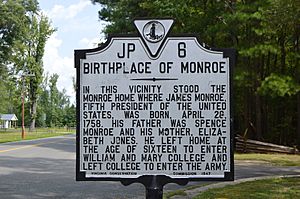
Monroe's family came from Scotland and Wales. His great-great-grandfather, Patrick Andrew Monroe, came from Scotland. His mother's father, James Jones, came from Wales.
At age 11, Monroe went to Campbelltown Academy. He could only attend school for 11 weeks a year. This was because he was needed to work on the family farm. During this time, he became good friends with John Marshall. Marshall later became a very important judge.
Monroe's mother died in 1772, and his father died two years later. At 16, Monroe had to leave school. He needed to support his younger brothers. His uncle, Joseph Jones, helped him. His uncle was a member of the Virginia House of Burgesses. He took Monroe to Williamsburg, Virginia, the capital. There, Monroe enrolled in the College of William and Mary. His uncle also introduced him to important people. These included Thomas Jefferson, Patrick Henry, and George Washington.
In 1774, people in the Thirteen Colonies were upset with the British government. Monroe joined the protests against the British governor of Virginia. He even took part in storming the Governor's Palace.
Monroe's Time in the Revolutionary War
In early 1776, Monroe left college. He joined the 3rd Virginia Regiment in the Continental Army. In December, he fought in a surprise attack. This was the Battle of Trenton against Hessian soldiers. Monroe was badly wounded in the battle. He suffered a cut artery and almost died.
After the battle, George Washington praised Monroe for his bravery. Monroe was promoted to captain. Once he recovered, he went back to Virginia. He tried to recruit his own company of soldiers. His bravery in the battle was shown in famous paintings. These include The Capture of the Hessians at Trenton, December 26, 1776 by John Trumbull.
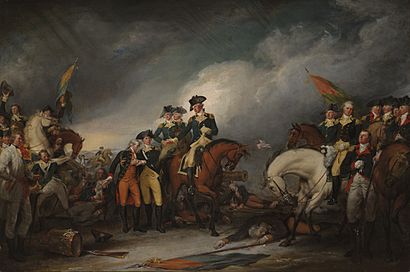
Monroe later became a lieutenant colonel. However, he struggled to find enough recruits for his regiment. He then returned to Williamsburg to study law. He became a student of Virginia Governor Thomas Jefferson.
As the war continued, the British focused on the Southern colonies. Virginia's capital moved to Richmond. Monroe went with Jefferson to the new capital. Jefferson, as governor, made Monroe a colonel in the militia. Monroe helped set up a messenger network. This helped coordinate with the Continental Army.
Monroe could not raise an army due to a lack of recruits. He was not present when the British raided Richmond. He also did not fight in the Siege of Yorktown. This was frustrating for him. Monroe is considered the last U.S. president who fought in the American Revolutionary War. He was an officer in the Continental Army and saw combat.
After the war, Monroe continued studying law with Jefferson until 1783. He wasn't very interested in law itself. But he thought it would help him gain wealth and political power. He became a lawyer in Fredericksburg, Virginia.
Monroe's Political Journey
In 1782, Monroe was elected to the Virginia House of Delegates. He then served in the Congress of the Confederation from 1783 to 1786. During this time, he traveled through Western New York and Pennsylvania. He wanted to understand the conditions in the Northwest. This trip made him believe the U.S. needed to control the Northwest.
Monroe became a strong supporter of expanding the country westward. He helped write and pass the Northwest Ordinance. This law created the Northwest Territory. It set up how the federal government would manage lands west of Pennsylvania. During this time, Jefferson continued to guide Monroe. Monroe also became friends with James Madison.
Monroe left Congress in 1786 to focus on his law career. In 1788, he was a delegate to the Virginia Ratifying Convention. He was against approving the U.S. Constitution at first.
In 1790, he was elected to the Senate. He became a leader of the Democratic-Republican Party. He left the Senate in 1794 to become President George Washington's ambassador to France. He had some early successes there. He helped protect U.S. trade from French attacks.
Later, the U.S. and Great Britain signed the Jay Treaty. This angered both the French and Monroe. Despite this, Monroe gained French support for U.S. shipping rights on the Mississippi River. In 1795, the U.S. and Spain signed Pinckney's Treaty. This treaty gave the U.S. limited rights to use the port of New Orleans. Washington decided to call Monroe back home in 1796.
Monroe was elected Governor of Virginia in 1799. He strongly supported Jefferson's run for president in 1800.
As President Jefferson's special representative, Monroe helped with the Louisiana Purchase. This deal almost doubled the size of the United States. Monroe later had a disagreement with James Madison. This was after Madison rejected a treaty Monroe had made with Britain. Monroe tried to run against Madison for president in 1808 but lost. However, he joined Madison's government as Secretary of State in 1811.
During the War of 1812, Monroe served as both Secretary of State and Secretary of War. His leadership during the war made him a likely successor to Madison. He easily won the 1816 presidential election. He defeated Federalist candidate Rufus King.
Becoming President (1817-1825)
As president, Monroe signed the Missouri Compromise. This agreement allowed Missouri to join the Union as a slave state. It also banned slavery in new territories north of a certain line (36°30′ parallel). Monroe was against limiting slavery anywhere. But he signed the Compromise into law in 1820. He believed it was the best option for the country at the time.
Two years into his presidency, Monroe faced an economic crisis. It was called the Panic of 1819. This was the first major economic downturn in the U.S. since the Constitution was approved. It happened because imports and exports went down. Also, farm prices dropped as global markets adjusted after the War of 1812 and the Napoleonic Wars.
Monroe did not have much power to fix the economy directly. Banks were mostly controlled by the states. He asked Congress to raise tariffs (taxes on imported goods). This would help American industries. Congress eventually raised tariffs in 1824. The panic led to high unemployment and many bankruptcies.
In foreign affairs, Monroe and Secretary of State John Quincy Adams wanted to be friendly with Britain. They also wanted to expand U.S. territory from the Spanish Empire. In 1817, the U.S. and Britain signed the Rush–Bagot Treaty. This treaty limited naval weapons on the Great Lakes. It also made the border between the U.S. and Canada peaceful.
The Treaty of 1818 with Great Britain set the U.S.-Canada border. It fixed the border from Minnesota to the Rocky Mountains at the 49th parallel. It also allowed the U.S. and Britain to share control of Oregon Country for ten years. These treaties helped trade and avoided a naval arms race. Later, the U.S. signed a treaty with Russia in 1824. This treaty set the southern border of Russian territory in North America.

In 1819, the Adams–Onís Treaty with Spain was signed. The United States gained Florida through this treaty. It also set the western border with New Spain (Mexico).
Monroe supported the Latin American countries fighting for freedom from Spain. He wanted the U.S. to show sympathy for these new republics. He did not want military involvement. He believed direct U.S. action might cause other European powers to help Spain.
In March 1822, Monroe officially recognized several new countries. These included Argentina, Peru, Colombia, Chile, and Mexico. All of them had won their independence from Spain.
In 1823, Monroe announced the Monroe Doctrine. This policy stated that the United States would oppose any European interference in the Americas. It became a very important part of American foreign policy. Monroe was also part of the American Colonization Society. This group supported sending freed slaves to Africa. The capital of Liberia, Monrovia, is named after him.
New States Join the Union
Five new states joined the United States during Monroe's presidency:
- Mississippi – December 10, 1817
- Illinois – December 3, 1818
- Alabama – December 14, 1819
- Maine – March 15, 1820
- Missouri – August 10, 1821
Life After the Presidency
After his presidency ended on March 4, 1825, James Monroe lived at Monroe Hill. This area is now part of the University of Virginia. He served on the university's Board of Visitors. He worked with former presidents Jefferson and Madison there.
He and his wife, Elizabeth, lived at Oak Hill in Aldie, Virginia. Elizabeth died on September 23, 1830, at age 62.
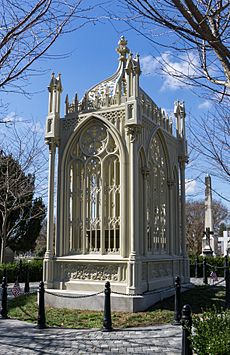
After Elizabeth's death, Monroe moved to New York City. He lived with his daughter, Maria Hester Monroe Gouverneur. Monroe's health began to decline in the late 1820s. He died on July 4, 1831, at age 73. He passed away from heart failure and tuberculosis. He was the third president to die on Independence Day. His death was 55 years after the Declaration of Independence. It was also five years after John Adams and Thomas Jefferson died.
Monroe was first buried in New York. Later, in 1858, his body was moved. He was re-buried at the President's Circle in Hollywood Cemetery in Richmond, Virginia. His tomb is a U.S. National Historic Landmark.
Monroe's Family Life
On February 16, 1786, Monroe married Elizabeth Kortright in New York City. She was the daughter of a wealthy trader. Monroe met her while he was serving in Congress.
After a short honeymoon, the Monroes lived with Elizabeth's father. Then they moved to Virginia. They settled in Charlottesville, Virginia, in 1789. In 1799, they bought an estate called Ash Lawn–Highland.
The Monroes had three children:
- Eliza Monroe Hay was born in 1786. She went to school in Paris when her father was ambassador to France. In 1808, she married George Hay. He was a well-known lawyer. She died in 1840.
- James Spence Monroe was born in 1799. He died when he was only sixteen months old.
- Maria Hester Monroe (1802–1850) married her cousin, Samuel L. Gouverneur. Their wedding was on March 8, 1820, at the White House. She was the first child of a president to get married there.
Monroe and Slavery
Monroe owned several farms, called plantations, and many slaves throughout his life. However, his plantations were not very profitable. He was often away for his political work. Overseers managed the farms and treated the slaves harshly. Even so, the plantations barely made enough money to cover their costs.
Monroe often spent a lot of money. He sometimes sold property, including slaves, to pay his debts. The labor of his slaves also supported his daughter, son-in-law, and brother.
During his presidency, Monroe believed slavery was wrong. He supported the idea of individual slave owners freeing their slaves. But he also thought that trying to end slavery completely would cause more problems. Monroe believed that slavery had become a lasting part of life in the Southern states. He felt it could only be removed by divine intervention. Like many slave owners in the Upper South, he believed the government's main job was to keep "domestic tranquility" for everyone. He also thought the government should support landowners like himself.
Monroe's Legacy and Memorials
How History Remembers Monroe
Historians and political experts generally rank Monroe as an above-average president. During his time in office, the United States started to focus more on issues within its own borders. It began to turn away from European affairs.
His presidency saw the U.S. solve many border problems. This was done through agreements with Britain and by gaining Florida from Spain. Monroe also helped ease tensions between different parts of the country. He supported the Missouri Compromise and sought support from all regions. Some experts believe Monroe was a more effective leader than some earlier presidents.
Places Named After Monroe
The capital city of Liberia is named Monrovia after Monroe. It is the only national capital besides Washington, D.C., named after a U.S. president. Many places are named after him, including seventeen Monroe counties. Towns like Monroe, Maine, Monroe, Michigan, and Monroe, Georgia also bear his name. Fort Monroe is named for him too.
Monroe has been shown on U.S. money and stamps. This includes a 5¢ Liberty Issue postage stamp from 1954.
Monroe was the last U.S. president to wear a powdered wig and knee-breeches. This was the style of the late 1700s. Because of this, he was nicknamed "The Last Cocked Hat." He was also the last president who was never photographed.
See also
 In Spanish: James Monroe para niños
In Spanish: James Monroe para niños



